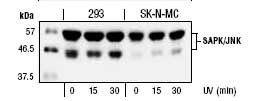559304 Sigma-AldrichAnti-SAPK/JNK Rabbit pAb
This Anti-SAPK/JNK Rabbit pAb is validated for use in Immunoblotting, Immunocytochemistry for the detection of SAPK/JNK.
More>> This Anti-SAPK/JNK Rabbit pAb is validated for use in Immunoblotting, Immunocytochemistry for the detection of SAPK/JNK. Less<<Prodotti consigliati
Panoramica
| Replacement Information |
|---|
Tabella delle specifiche principali
| Species Reactivity | Host | Antibody Type |
|---|---|---|
| H, M, R | Rb | Polyclonal Antibody |
Prezzi e disponibilità
| Numero di catalogo | Disponibilità | Confezionamento | Qtà/conf | Prezzo | Quantità | |
|---|---|---|---|---|---|---|
| 559304-200UL |
|
Fiala di plastica | 200 ul |
|
— |
| Product Information | |
|---|---|
| Form | Liquid |
| Formulation | In 150 mM NaCl, 10 mM HEPES, 50% glycerol, 0.01% BSA, pH 7.5. |
| Positive control | UV treated HEK293 cells |
| Preservative | None |
| Quality Level | MQ100 |
| Biological Information | |
|---|---|
| Immunogen | a full-length, recombinant, human p54 SAPK/JNK2 fusion protein |
| Immunogen | Human |
| Host | Rabbit |
| Isotype | IgG |
| Species Reactivity |
|
| Antibody Type | Polyclonal Antibody |
| Physicochemical Information |
|---|
| Dimensions |
|---|
| Materials Information |
|---|
| Toxicological Information |
|---|
| Safety Information according to GHS |
|---|
| Safety Information |
|---|
| Product Usage Statements |
|---|
| Packaging Information |
|---|
| Transport Information |
|---|
| Supplemental Information |
|---|
| Specifications |
|---|
| Global Trade Item Number | |
|---|---|
| Numero di catalogo | GTIN |
| 559304-200UL | 04055977192421 |
Documentation
Anti-SAPK/JNK Rabbit pAb MSDS
| Titolo |
|---|
Anti-SAPK/JNK Rabbit pAb Certificati d'Analisi
| Titolo | Numero di lotto |
|---|---|
| 559304 |
Riferimenti bibliografici
| Panoramica delle referenze |
|---|
| Gupta, S., et al. 1996. EMBO J. 15(11), 2760. Coso, O.A., et al. 1995. Cell 81, 1137. Derijard, B., et al. 1994. Cell 76, 1025. Kyriakis, J.M., et al. 1994. Nature 369, 156. Hibi, M., et al. 1993. Genes Dev. 7, 2135. Kyriakis, J.M. and Avruch, J. 1990. J. Biol. Chem. 265, 17355. |








